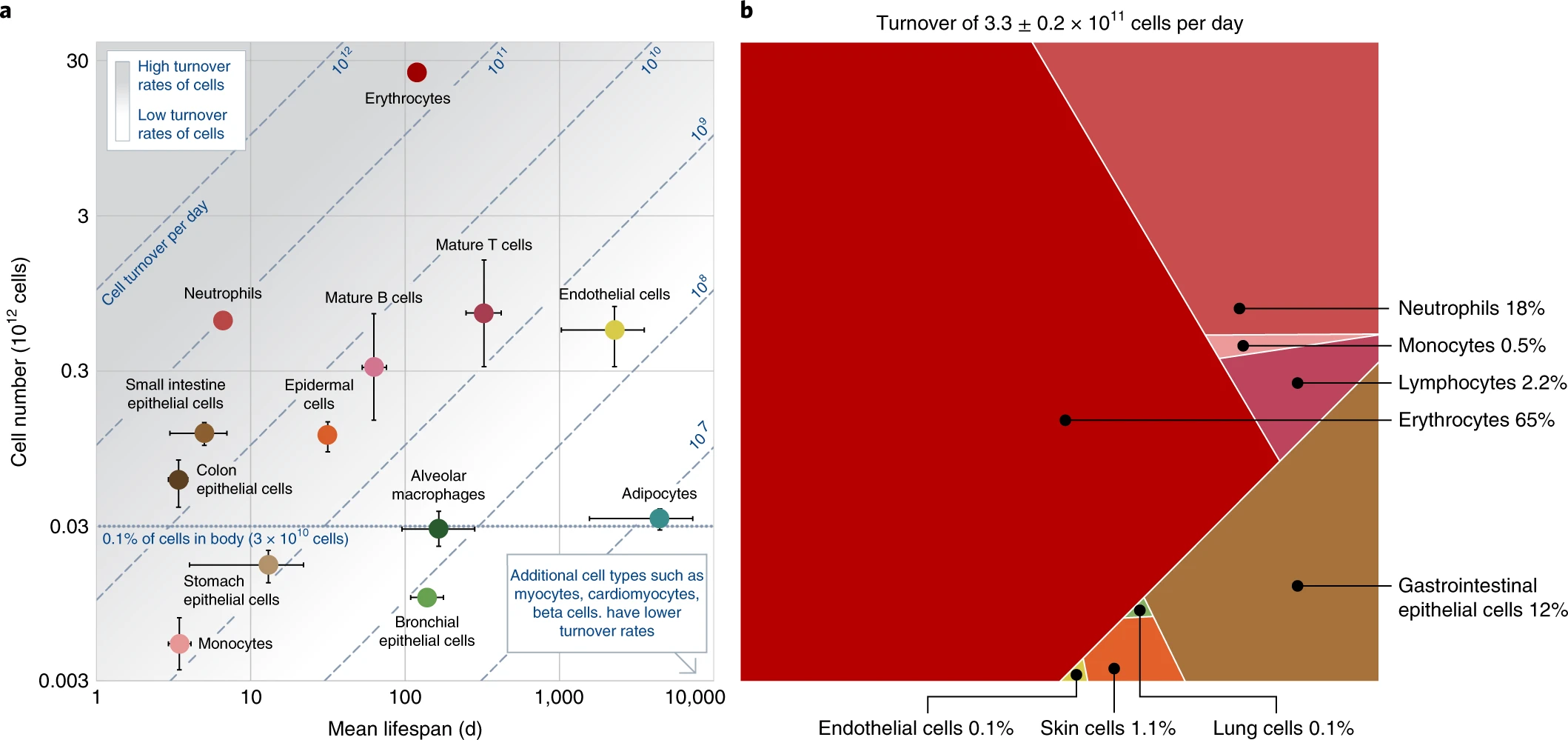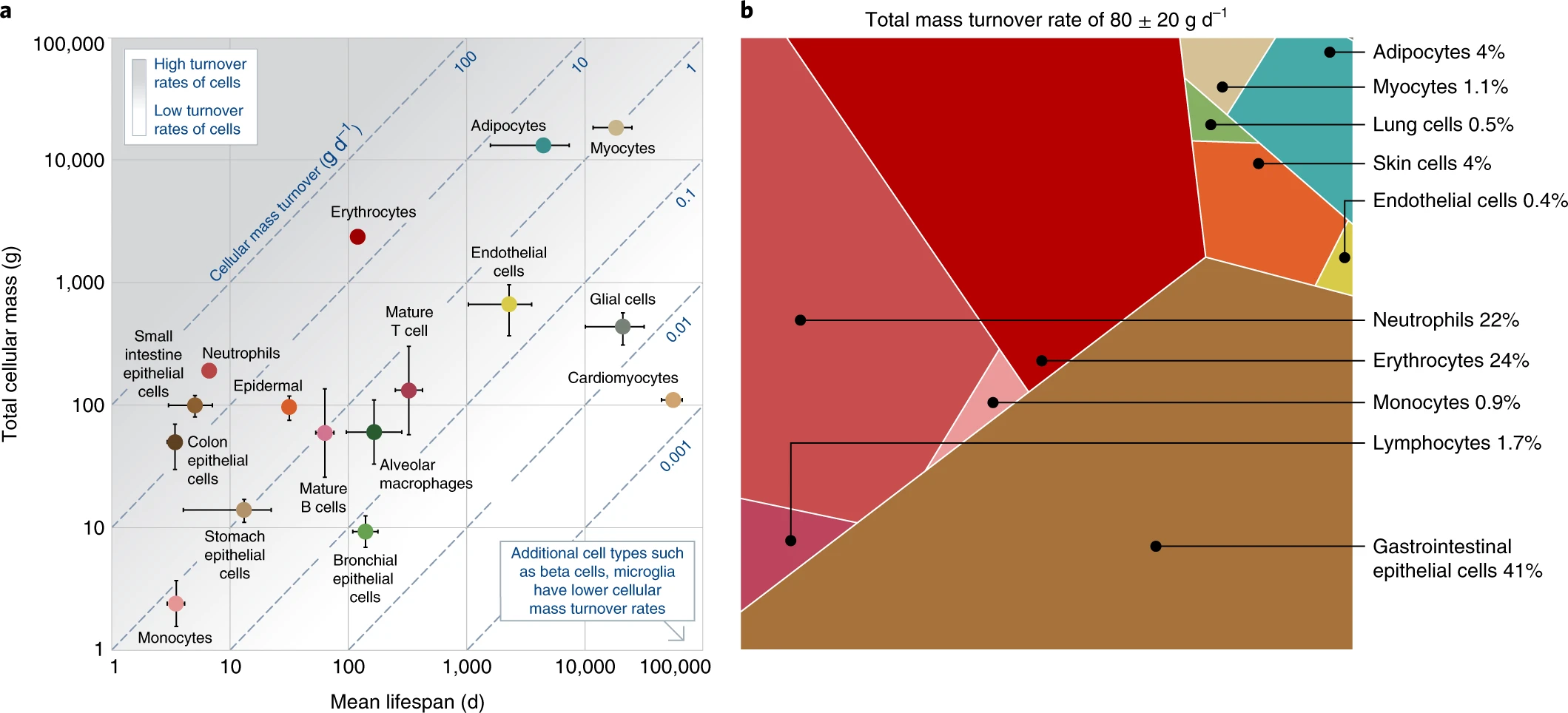4 million new cells per second
New research analysed the characteristics of all major cell types to obtain a complete quantitative description of cell turnover. The total cell mass turnover is 80 ± 20 grams per day.
New findings on cell turnover distribution in the human body
Recent research has analyzed the characteristics of all major cell types to obtain a comprehensive quantitative description of cell turnover. Total cell mass turnover is 80 ±20 grams per day, dominated by blood cells and intestinal epithelial cells. In terms of cell numbers, nearly 90% of the total is blood cells.
To better understand the function of the human body in health and disease, it is of great interest to quantify our cellular composition and turnover. It is estimated that the number of cells in the adult body is approximately 30 ±0.5 ×1012, of which approximately 90% are blood cells. Beyond this static view, there was no corresponding comprehensive census of the dynamics of cell and tissue death and regeneration.
A paper published in Nature Medicine attempts to fill the gap regarding the overall dynamics of cell turnover in the human body by quantifying cell turnover rates in terms of both number and mass. The investigation looked at the standard reference person, which is historically defined as a male between 20-30 years of age, weighing 70 kg and 170 cm tall. Because the cell turnover rate can change due to various diseases, the researchers added the qualifier "healthy" to the standard reference.
Daily cell turnover rate
The daily cell turnover rate is defined as the average daily number of cell deaths in a specific cell population. The study authors characterized human daily cell turnover by applying the equation β = n/τ, where β is the cell turnover rate, n is the number of cells, and τ is the average lifespan of each cell type, estimated from a literature survey.
The daily cell turnover rate is influenced by two factors: the number of cells and their average lifespan. Thus, a given population of cells will contribute substantially to the overall cell turnover rate if it is large in number and possesses a relatively short lifespan. The main cell types that were the main focus in the analysis are those that comprise at least 0.1% of the 30 trillion cells that make up the human body or those with a particularly fast turnover of τ <10 d (days).
Analysis of many of the tissues deemed relevant (e.g., sperm cells, kidney cells, and osteocytes) often showed negligible contributions in both number and mass. By summing the daily cell turnover rates for each cell type, their contribution to the overall daily turnover rates of human cells was mapped.
It was determined that the total cell turnover rate of the human body is 0.33 ±0.02 ×1012 (330 ±20 billion) cells d-1 (equivalent to approximately 4 million cells s-1). Approximately 86% of these cells are blood cells, mostly of bone marrow origin. Nearly all of the remaining 14% are gut cells. The three largest contributors to cell turnover in the human body are jointly responsible for about 96% of total turnover: erythrocytes, neutrophils, and intestinal and gastric epithelia.
The rate of cell mass turnover
The rate of cell mass turnover is defined as the average total mass of cells in a specific cell population (most commonly a certain cell type) that die (or are released) per unit time. Assuming a characteristic cell mass, m, for a cell type that includes n cells with an average life span of τ days, the cell mass turnover rate for the cell type corresponds to µ = mn/τ = βm. This definition essentially considers the balance between the mass of cells that die and those that replace them.
The total turnover rate of human cell mass is 80 ±20 g d-1. Despite their ubiquity, blood cells account for only ≈40% of total cell mass turnover because of their relatively low cell mass of ≈100-300 pg. This contrasts with their ≈80% dominance of total cell turnover. Gastrointestinal tract epithelial cells also contribute approximately 40% of cell mass turnover because of their higher single cell unit mass (≈1,000 pg) and short lifespan. Note that because of their exceptionally long lifespan, adipocytes and muscle cells contribute only about 5% of total mass turnover, even though they account for 75% of total cell mass.
The ship of Theseus paradox
A 70-kg reference person with 30 trillion host cells and 46 kg of cell mass (the other 24 kg is due to extracellular fluids and solids) produces this number of cells every 80 d and this amount of cell mass every year and a half. The difference in timing stems from the fact that most turnover occurs in small to medium cells, whereas much of the cell mass is concentrated in relatively heavy cells with an average lifespan of more than 10 years. However, not all parts of the human body are replaced (e.g., most neurons in the brain and cells in the lens of the eye), so complete turnover never occurs.
This analysis can help scholars answer many questions revolving around the topic of body regeneration processes in health and disease. For example, how does tumor cell turnover compare with total patient cell turnover? What is the energy and biosynthetic toll of tumor growth and what impact does it have on resource allocation?
The analysis also provides more information to ponder about the Theseus' ship paradox. Thanks to this study, it is possible to discuss in quantitative terms which fraction is replaced and in how long.
Source:
Sender R, Milo R. The distribution of cellular turnover in the human body. Nat Med. 2021 Jan;27(1):45-48. doi: 10.1038/s41591-020-01182-9. Epub 2021 Jan 11. PMID: 33432173.

